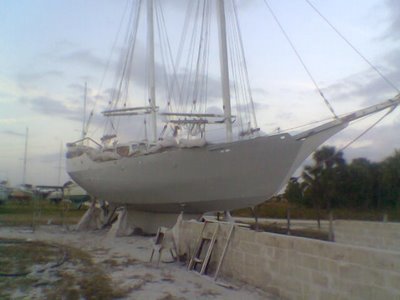On Free Spirit Projects
Though she sailed over from South Africa on her own bottom in 1999 and could be ready for the water with only a day or two's preparations, Free Spirit is very much a work in progress. We've accumulated the lions share of equipment we wamt for her, but all of this will require installation once we get there.
Recently aquired are:
Interphase Twinscope Phased array sonar (like underwater radar)
SSB, Weatherfax, and NOAA Satelite imagery reception capability
Currently designing an auxiliary helm and autopilot system. I think I will build my own microcontroller system to take NMEA data and issue helm commands via a chain drive gearmotor to the wheel shaft. I need a more robust system than can be easily had in the yacht marketplace. This "crewmember" must be more reliable than the regular crew, and be able to steer for days or weeks without rest or worry of breakdown. The solution is to overbuild the system, to make it more like a piece of industrial equipment than an elegant yacht toy. I should be able to build a system that should operate reliably for years on end if I select components with a 1000% load rating (if the gearmotor needs to have 400 inch lbs torque, then I use one rated for 4000 continuous duty). This should be an interesting project.
Then theres the trailer.

Built from a 1942 trailer house frame and axle living its fourth life, now reincarnated as a 14' utility trailer. Previous lives include a flatbed car hauler and a suspension-bridge style log hauler. I wonder what it will be next?



0 Comments:
Post a Comment
<< Home